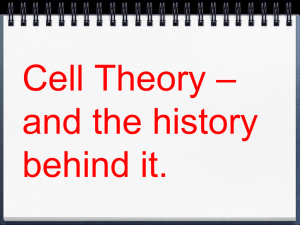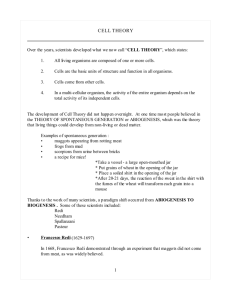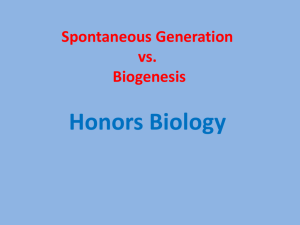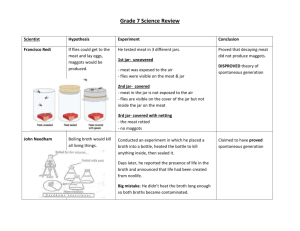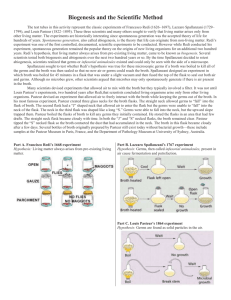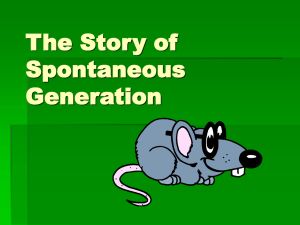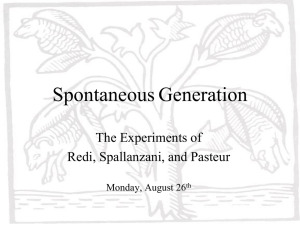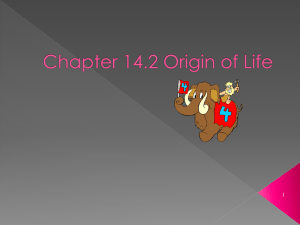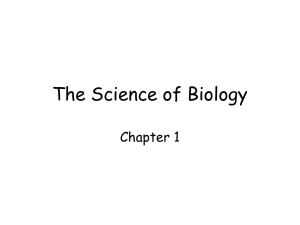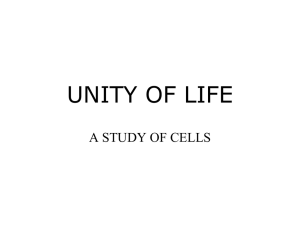Where Does Life Come From.doc
advertisement
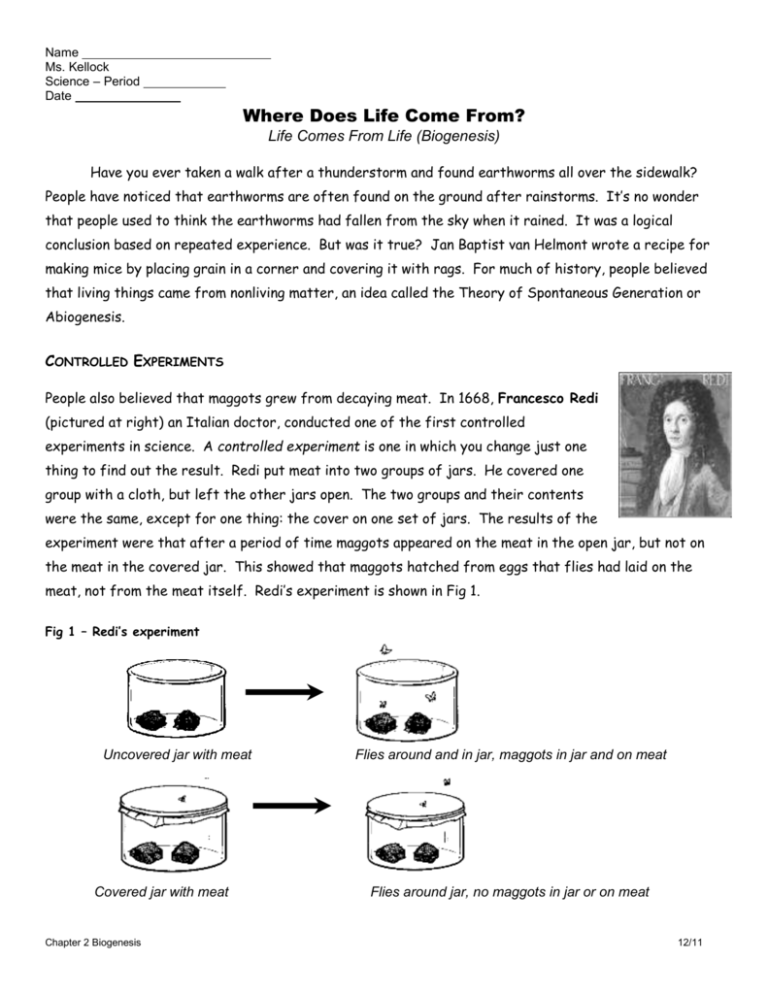
Name Ms. Kellock Science – Period Date Where Does Life Come From? Life Comes From Life (Biogenesis) Have you ever taken a walk after a thunderstorm and found earthworms all over the sidewalk? People have noticed that earthworms are often found on the ground after rainstorms. It’s no wonder that people used to think the earthworms had fallen from the sky when it rained. It was a logical conclusion based on repeated experience. But was it true? Jan Baptist van Helmont wrote a recipe for making mice by placing grain in a corner and covering it with rags. For much of history, people believed that living things came from nonliving matter, an idea called the Theory of Spontaneous Generation or Abiogenesis. CONTROLLED EXPERIMENTS People also believed that maggots grew from decaying meat. In 1668, Francesco Redi (pictured at right) an Italian doctor, conducted one of the first controlled experiments in science. A controlled experiment is one in which you change just one thing to find out the result. Redi put meat into two groups of jars. He covered one group with a cloth, but left the other jars open. The two groups and their contents were the same, except for one thing: the cover on one set of jars. The results of the experiment were that after a period of time maggots appeared on the meat in the open jar, but not on the meat in the covered jar. This showed that maggots hatched from eggs that flies had laid on the meat, not from the meat itself. Redi’s experiment is shown in Fig 1. Fig 1 – Redi’s experiment Uncovered jar with meat Covered jar with meat Chapter 2 Biogenesis Flies around and in jar, maggots in jar and on meat Flies around jar, no maggots in jar or on meat 12/11 In the late 1700’s, Lazzaro Spallanzani designed an experiment that showed that tiny organisms came from other tiny organisms in the air. He sterilized broth in two sets of flasks, sealing one group, and leaving the other group open to the air. The open flask became cloudy with organisms. The sealed flask developed no organisms. When he opened the sealed flasks, they then did become contaminated. Spallanzani’s experiment showed that organisms from the air entered one flasks and not the other because it was sealed, and it was the organisms from the air that grew in the broth. Spallanzani’s experiment is shown in Fig 2 Fig 2 – Spallanzani’s experiment Broth boiled, flask left open Broth boiled Open flask develops organisms flask sealed Sealed flask remains uncontaminated Biogenesis It was not until the mid-1800’s that Louis Pasteur, a French chemist, showed conclusively that living things do not come from nonliving materials. In the experiment illustrated in Fig 3, Pasteur boiled broth in flasks with long, curved necks. The broth remained uncontaminated for a long time. When dust that collected in the curved neck of one flask was allowed to mix with the broth, the broth in that flask became contaminated with bacteria. The work of Redi, Spallanzani, Pasteur, and others provided enough evidence to finally disprove the Theory of Spontaneous Generation. This theory was replaced with Biogenesis, the theory that living things come from other living things. Fig 3 – Pasteur’s Experiment Boiled broth Boiled broth exposed to air Chapter 2 Biogenesis Boiled broth exposed to air Broth exposed to dust broth remains uncontaminated Broth shows bacterial growth 12/11 Name Ms. Kellock Science – Period Date WHERE DOES LIFE COME FROM? The Development of the Cell Theory Pre-read the questions below, and then read the article about the experiments done by Francesco Redi, Lazzaro Spallanzani, and Louis Pasteur. Use the information to answer the questions below. 1. Define the following terms: a. Spontaneous Generation/Abiogenesis b. Biogenesis c. Controlled experiment 2. Summarize the results of Redi’s, Spallanzani’s, and Pasteur’s experiments. For each experiment - Write a proper hypothesis, identify the control and experimental groups, identify the independent variable, and write a conclusion. Francesco Redi (early 1700’s) HYPOTHESIS EXPERIMENTAL SET-UP Control Group Experimental Group INDEPENDENT VARIABLE CONCLUSION Chapter 2 Biogenesis 12/11 Lazzaro Spallanzani (late 1700’s) HYPOTHESIS EXPERIMENTAL SET-UP Control Group Experimental Group INDEPENDENT VARIABLE CONCLUSION Louis Pasteur (mid 1800’s) HYPOTHESIS EXPERIMENTAL SET-UP Control Group Experimental Group INDEPENDENT VARIABLE CONCLUSION 3. Explain how Pasteur’s results disproved the Theory of Spontaneous Generation. 4. State the Theory of Biogenesis 5. Which scientist – Hooke, Van Leeuwenhoek, Schleiden, Schwann, or Virchow – discovered the part of the cell theory that supports Pasteur’s conclusion? What did he observe that supported Pasteur’s conclusion? Chapter 2 Biogenesis 12/11

